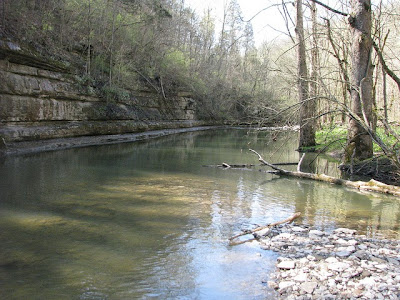 |
| Pool in the Lower Howard's Creek - Clark Co., Ky. |
Contrast out perspective with that of our guide: Clare Sipple, the Preserve Manager, has a professional and personal connection with this land. Her earliest memory of visiting the creek dates to age 3 - traversing the snow-covered creek banks on a horse-drawn sled. Her passion for Lower Howard's Creek was evident through both the knowledge of an expert and the wonderment of a child.
Soon we descended the trail into the gorge formed by the creek. As we trekked, Sipple regaled us with detailed explanation of the many flora (several endangered) we encountered. Rare plants in the Preserve include water stitchwort, running buffalo clover, Kentucky viburnum, white walnut, and nodding rattlesnake-root. A second growth forest largely covers the LHC Preserve with approximately 400 different plant species growing under the canopy.
But this is not merely a State Nature Preserve filled with flora and fauna, it is also a Heritage Park that contains multiple structures listed in the National Register of Historic Places. Though described today as remote, one must examine LHC with the sense that it was once an industrial center for water-powered stone milling from the late 1700s until the mid-19th century.
Ceramic Shards and the Martin/Bush House
 |
| Martin/Bush House at Lower Howard's Creek |
The John and Rachel Martin House began as a log cabin in the 1780s, but two stone additions were added in the following decades to create a rather significant structure. Though the log cabin is lost to history, great effort is being made to preserve the stone remaining stone structure. And though the National Register of Historic Places (as well as the majority of documentation on the property) identifies the property as the “Martin House,” it may well be in error.
To understand this conundrum, local historian Harry Enoch provided me with several documents explaining the long standing confusion. Apparently, Clark County’s history contains no fewer than five John Martins. The John Martin associated with Lower Howard’s Creek owned a 250 acre farm here, but it was situated outside the bounds of what is now the Preserve. Enoch and Sipple both suggest that the stone house and nearby mill were those belonging to Jonathan Bush as the Bush family held title to the land and the elaborate tablet over the tomb box from Jonathan’s second wife, Diana Emerson Bush, was discovered near this significant stone house.
Whether Martin or Bush, the house and the nearby mill are both spectacular examples of stone construction in this remote corner of the world. The sheer size and grandeur of the structures seem to support the suggestion that the area was economically connected to the rest of the nation and world.
The Bush Mill
 |
| The old Bush Mill (clockwise from top: remains, rendering from Patent No. 3, remains of chimney) |
Throughout the Preserve, the limestone walls seemingly indigenous to Kentucky abound. Several have been rebuilt in the past decade through joint efforts with the Dry Stone Conservancy. Two parallel dry laid limestone walls create a wide path along what would have been part of the wilderness road linking Fort Boonesborough to the Blue Licks.
Murder at Hieronymous Place
 |
| The chimney at Hieronymous Place |
John Martin, who lived across the creek and is different than the other five John Martins mentioned above, rushed over to see what the commotion was about; he was instantly killed by Sowers. Finally, John Martin’s brother, Stanley, arrived. Seeing his brother dead on the floor must have sent him into a rage for the scene that followed would have appropriately fit into the song “Cell Block Tango” from the Broadway revival of Chicago. Stanley shot Sowers ten times with a .22 before bludgeoning Sowers head with the butt of not one, but two, shotguns. The force was such that neither shotgun was operable after the incident which the presiding judge described as “the bloodiest in Clark County history.” Unlike the ladies in the “Cell Block Tango,” the claims of self-defense and of temporary insanity were successful as the murder charges brought against Stanley Martin were ultimately dismissed.
 |
| Historic Marker for Capt. John Holder near Hall's on the River |
Most of the trails through the Preserve, including those which we traversed on our visit are accessible only on official tours which are conducted almost every Saturday on trails not connected with the John Holder Trail. For these guided treks, reservations are required and a $5 donation is suggested for those who are not members of the Friends of Lower Howard’s Creek. Information about these tours, and about the Preserve generally, are available at www.lowerhowardscreek.org.
Additional photographs are available here.
This column originally appeared in a recent issue of Preservation Matters,
a publication of the Blue Grass Trust for Historic Preservation.

Comments